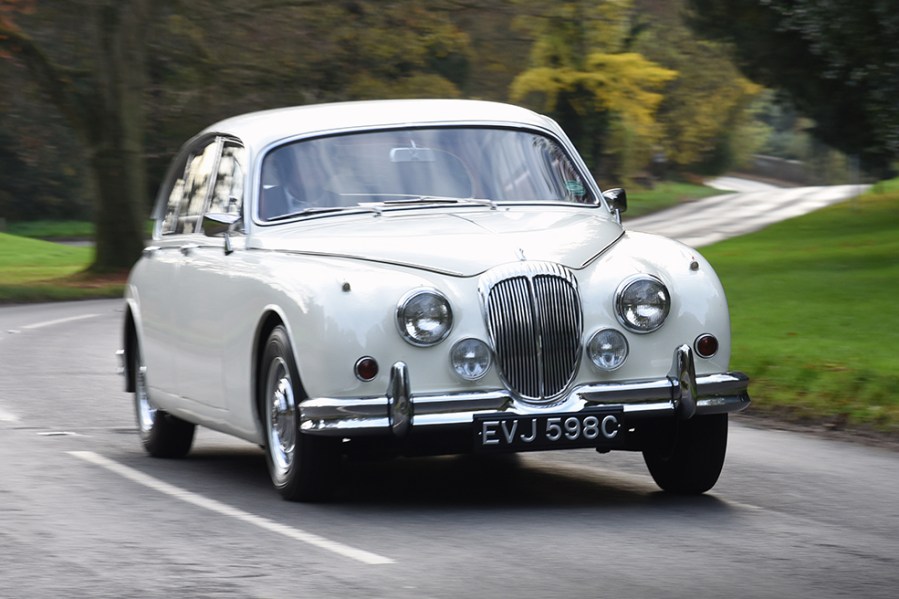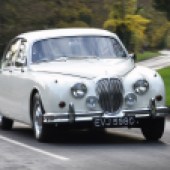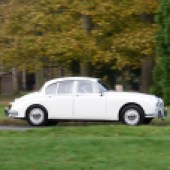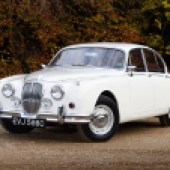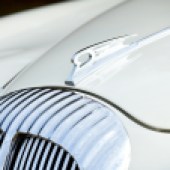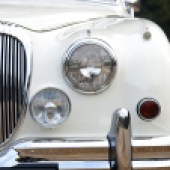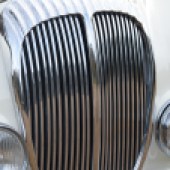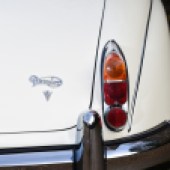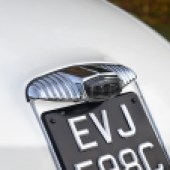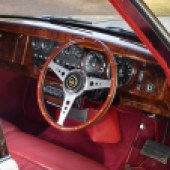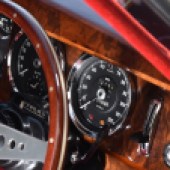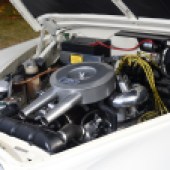Fancy a Jaguar Mk2 but can’t justify the big prices? The Daimler V8 could provide the answer. Here’s how to buy a great one
Words: Sam Skelton Images: Paul Walton
When Jaguar bought Daimler in 1960, its plans to launch a smaller saloon based on the Vauxhall Cresta were abandoned. But Daimler distributor Stratstone wanted something smaller to sell alongside the Majestic, and incentivised Jaguar to create one by offering to give up its secondary VW franchise if something suitable could be created.
The most cost-effective solution was to take the Jaguar Mk2 and fit Daimler’s 2.5 litre V8 as fitted to the SP250 sports car – along with an automatic gearbox. A Daimler grille and rear plinth were fitted along with some minor interior changes, and the Daimler 2.5V8 was launched on October 8, 1962. Priced at £1786 against the £1664 of the Jaguar 3.4 Mk 2 manual, the 140bhp Daimler was pitched above the Jaguar 2.4 by over £200 and, initially, even more than the powerful 3.8-litre manual.
For 1967 the Daimler was updated alongside the contemporary Jaguars but avoided the cost-cutting measures – the newly titled V8-250 kept the leather trim and foglamps of the older car. The model was discontinued in 1969 and spent many years in the Jaguar’s shadow, but now they make for an intriguing, great-value classic. Here’s what you need to know when buying.
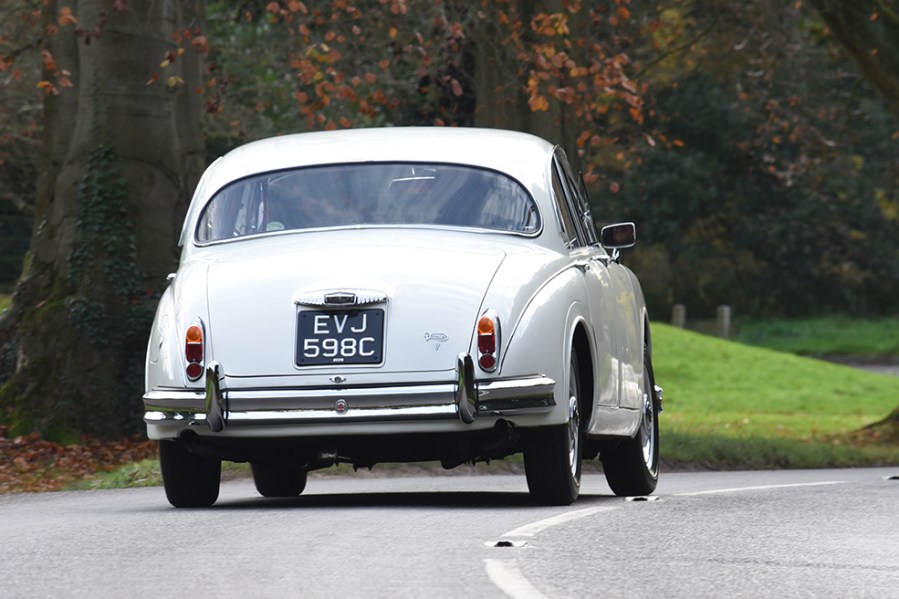
Bodywork
Much like the Jaguar upon which it’s based, the monocoque shell of the Daimler V8 hides several rust traps that if left untreated can render the car unsalvageable. Check the front chassis legs, as water can enter and rot out the front jacking points by the A-posts. While there check the bottom of the wings and how they sit relative to the doors – sill issues can deform the A-posts and thus adversely affect how the doors shut. This can only be done properly on a jig, so if there are bills for sill repairs that look too cheap, be worried. The Panhard rod mounting in the offside rear arch is a favourite spot for rot, as are the rear spring hangers and anti-roll bar mounts. Floorplans can rot out with alarming speed too, as can the area where the rear door and wheelarch spat meet. Water can also be trapped between panel skins, so check the bootlid and doors for corrosion along the lower lips.
Fortunately given the commonality with the Mk2, everything is available – though you might not like the prices. A door skin might be around £60, but you’re looking at nearer £3000 for a front wing given the complexity and size of the panel shape. By the time it’s welded on properly and painted, the overall total will be nearer to £4000 so if you’re looking at a car with suspect front wings, make sure that’s factored into the price. The good news is that repair sections can be had for under £100 depending upon where the problem is, and a good bodyshop can make repairs invisible.
Chromework can tarnish, but most parts are available in good used condition or new depending upon your budget. Only the grille and rear plinth are unique to the Daimler models.
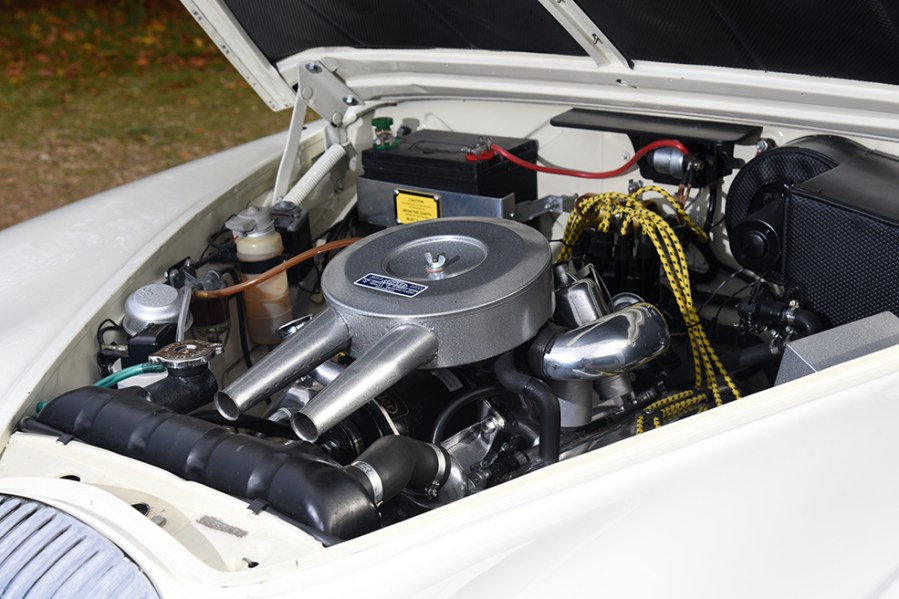
Engine and transmission
This is the one area in which the Daimler differs drastically from the Jaguar – and while opinions differ and the Jaguar 3.4 and 3.8 certainly have more power, the Edward Turner-designed V8 is an absolute gem and punches above its weight. Depending on your use, you’ll be likely to need an annual service – though if you’re doing over 6000 miles per year, we’d advise two.
Some V8s have been known to suffer piston crown failure, but from 1968 these were strengthened and most of the problem cars have already had replacement engines or pistons. It’s crucial to maintain the right concentration of anti-freeze in the cooling system – you need a 50/50 mix to prevent corrosion in the waterways. If the system develops leaks through excess pressure, this is likely the culprit. The centre bearings on the crankshaft can wear within 40,000 miles, and while replacement can be done in situ, it isn’t ideal. Oil pressure will drop with worn bearings – good figures are 15-20psi at idle and 35-45psi when running, but the gauge isn’t known for its accuracy. Rear crank oil seals can leak, and the only solution is replacement which means removing the engine, or you can keep topping the oil up if a small leak doesn’t worry you.
Most of these cars were fitted with Borg Warner Model 35 or D1/D2 type automatic gearboxes, but a handful were specified with Jaguar’s four-speed manual with overdrive –these are more likely to be the later V8-250 models. The Borg Warner boxes are known to be long lasting, so if it’s changing well on test there are unlikely to be issues. The same can be said for the Salisbury axle at the back – with routine maintenance this is a reliable unit.
Suspension, steering and brakes
Broadly, the suspension set-up is the same as on Jaguar’s Mk2 – though the front spring rates are different owing to the lower weight of the Daimler engine. Front suspension needs regularly greasing but is long-lived and hardy if correctly maintained. The front suspension is carried in a subframe and the front bushes can deteriorate, so should be checked regularly. When these bushes shear, it can affect the handling. Front wishbones can also wear.
Rear leaf springs can settle over time and the bushes that support them will need attention to ensure the springs still have the necessary support. The gas shocks on each corner shouldn’t pose any issues, as they tend to be good for high mileages. If the car feels sloppy in bends, the odds are an overhaul is needed – Mk2s and Daimler V8s are supple in terms of ride, but taut in the bends.
Most Daimler V8s have power steering, fitted to a Burman recirculating ball set-up. It’s the same set-up fitted to Jaguar Mk2s, and is largely problem free. Later models build upon this with sealed ball joints. The adjustable steering column can suffer slack, but it’s usually the bushes which are easy to replace.
Dunlop disc brakes and a Lockheed servo are standard fitment – again, like the Jaguar upon which the Daimler V8 is based – and if the brakes are in good condition, they’re effective. Sticking calliper pistons can be an issue in cars that have been laid up, while steel brake lines if still fitted ought to be replaced with Cunifer at the earliest opportunity. The handbrakes were never much cop, so don’t be worried if it’s not great on a test drive.
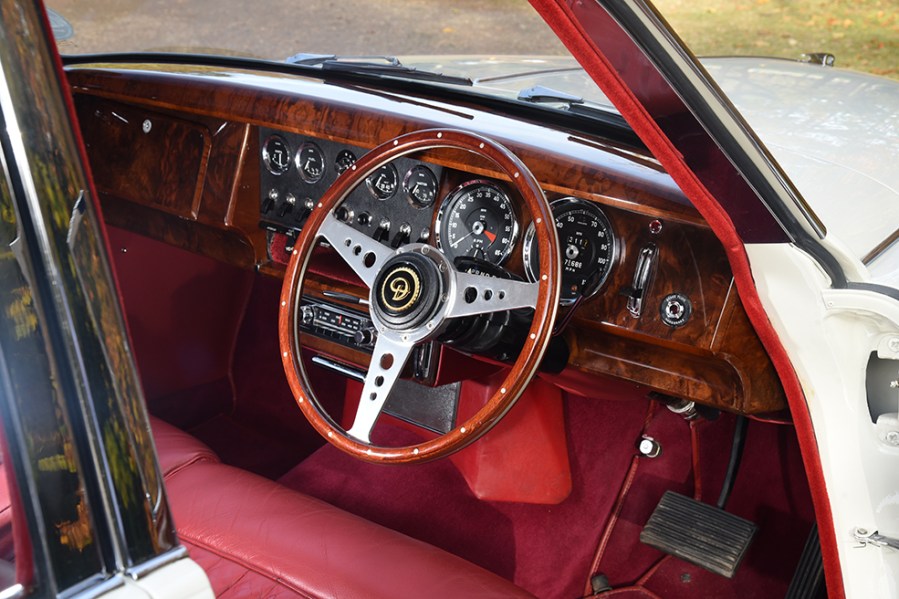
Interior, trim and electrics
A lot of the trim will be familiar to those who know the Jaguar Mk2, as most of the fittings and the complete basic layout was retained for the Daimler. The primary difference is the shaping of the front seats, which are squarer and trimmed so as to form a bench if both driver and passenger are adjusted the same way. While the V8 is perhaps a shade small to be considered a six-seater, the column shift of the automatic nonetheless allows the possibility for short distances.
The similarity means that all the issues you’d face with a Mk2 are present – check for lifting lacquer or veneer to the woodwork, as this will be expensive to replace – bank on just over £6000 to replace all the wood in the cabin, though individual items, especially second-hand, will likely cost less to replace. Splits or tears in the leather can also be expensive to have repaired, though there’s nothing in the cabin of a Daimler V8 that should be beyond the abilities of a reasonably decent local trimmer. You’re looking at around £2000 for a set of seat covers and maybe another £700 for replacement foams if you want to undergo a complete retrim, courtesy of Aldridge Trimming.
Unlike the later Jaguars, the Daimler V8-250 retained leather seat covers as standard, so if you’re looking at a car with vinyl someone has skimped on the retrim costs. It did however have padded vinyl door cappings and dashboard top, which can split through UV damage but are easily replaced. Provision was made for a radio, but these would have been fitted to the first owner’s specification when new, and likely upgraded since. The standard steering wheel should be black plastic like the Jaguar, but if someone has fitted a wood-rimmed unit it won’t devalue the car – it’s a matter of personal taste and original wheels are available.
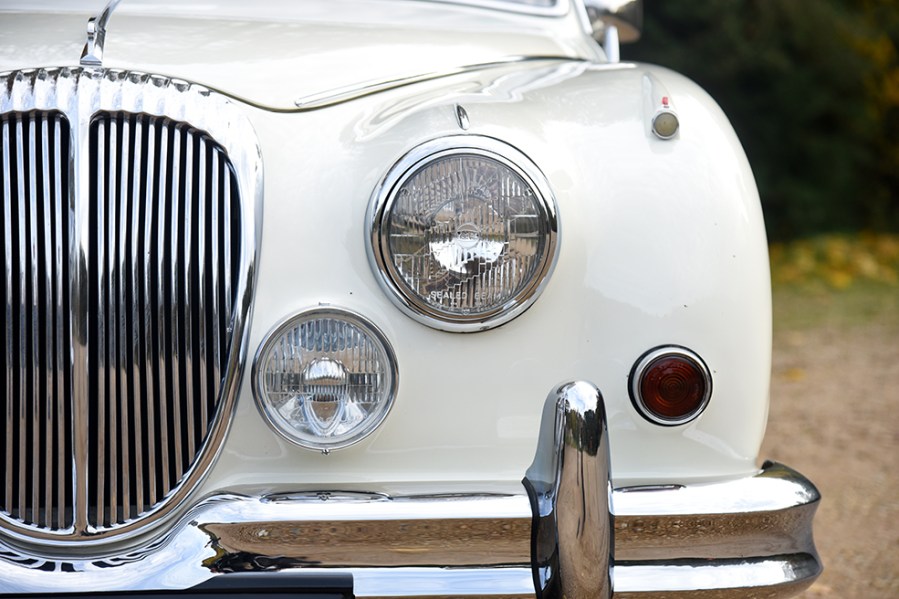
Daimler V8 250: our verdict
Far from being the poor relation, the Daimler V8 is arguably a better buy than the Jaguar Mk2. It’s rarer for starters, and decent examples are cheaper. It’s also more fun to drive than a Rover P5B, while also offering better value for money than the other well-known Mk2 alternative, the S-Type. While each of these cars will please its prospective owners, the Daimler combines the V8 burble of the Rover, the value of the S-Type and the traditional style of the Mk2 to make a car that has a more enduring appeal. The only compromise you might have to make, if a Mk2 had been on your shopping list, is automatic transmission – but given that the Daimler is more of a relaxed cruiser than the Jag it suits the ethos of the car.
The Jaguar clubs and the Daimler Lanchester Owners’ Club will be full of people happy to help and pretty much everything you need is available, too, making it an easy classic to own. Jaguar specialists will cater for the car given its similarity to the Mk2 – and mechanically, anywhere that caters for the Daimler SP250 should be able to help too.
The Daimler V8 has always offered better value than the equivalent Jaguar. In 2012, one in perfect order would have fetched the same £15,000 as a Jaguar 2.4 – and 10 grand less than the 3.4 with which it should perhaps more fairly be compared. It’s now worth less than a 2.4, making is less likely as a future appreciating asset than the Mk2, but with the best example now £20,000 or more, it’s gained a third in 10 years. You won’t find a savings account that would achieve that, and the Daimler would be far more fun.
A budget of £8000–12,000 will get you a nice and useable car, even if it’s not the best in the world. Spending below £6000 means you’re likely to buy something that needs a lot of work, and given the cost of panels and trim items, long term it’s a far riskier strategy than simply buying a nice one in the first place. Remember that a pair of front wings and a retrim will easily make the difference between project money and concours money, and that’s before you look at the rest of the car.
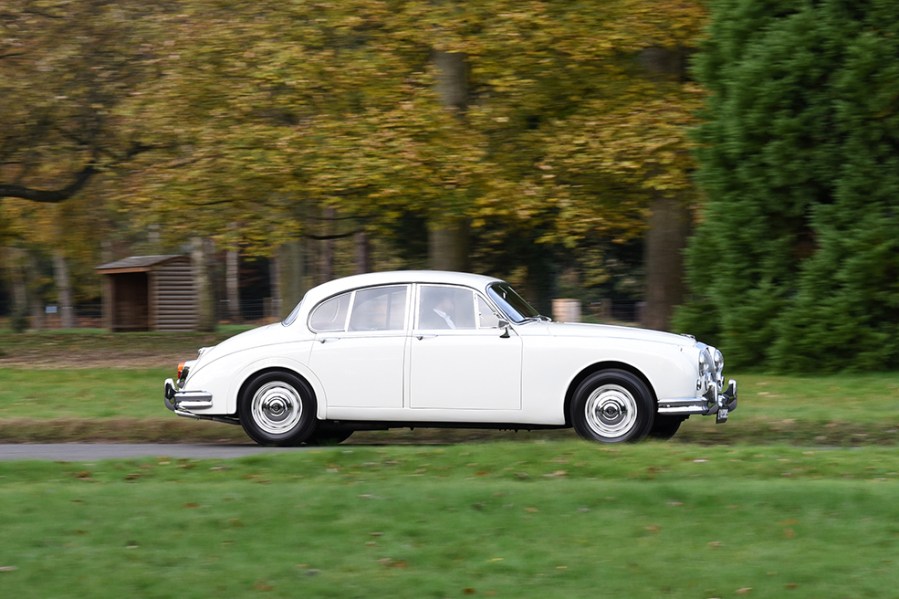
Daimler V8 250 timeline
1962
2.5V8 arrives as a belated replacement for the Conquest, broadly a Jaguar Mk2 fitted with Turner-designed 2.5 litre V8 and Borg-Warner automatic gearbox.
1967
Manual transmission becomes an option – £60 cheaper than the automatic model.
1967
Daimler 2.5V8 replaced by V8-250. Slimmer bumpers fitted, along with vinyl padded dash top and door cappings, heated rear window, reclining seats and negative earth electrics.
1969
Daimler V8-250 replaced by Daimler Sovereign 2.8, based on the Jaguar XJ6 2.8 model.

